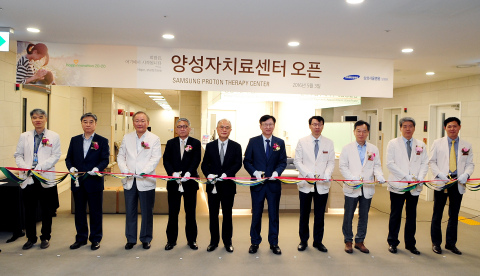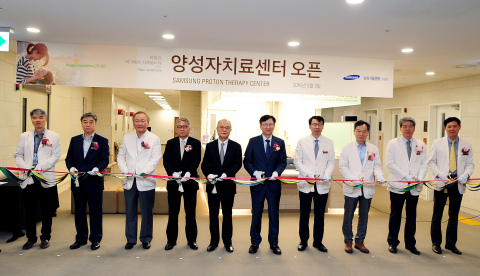TOKYO--(BUSINESS WIRE)--Sumitomo Heavy Industries, Ltd. (TOKYO:6302) (“SHI”) today announces that Samsung Medical Center (“SMC”) in Seoul, Korea has commenced proton therapy*1 and the opening ceremony was held on May 3, 2016.
The new proton therapy facility is equipped with cyclotron*2, which generates continuous and high intensity proton beam, and two rotating gantries. The facility has a provisional room that makes it possible to add the third treatment room with a rotating gantry in the future. The facility has two types of irradiation nozzle system, such as a multi-purpose nozzle in G1 treatment room and a dedicated scanning nozzle in G2 treatment room. The multi-purpose nozzle offers both conventional broad beam irradiation*3 and the advanced Pencil Beam Scanning (“PBS”), and each irradiation mode can be switched at random depending on target diseases. The dedicated scanning nozzle offers PBS for large field (Maximum 40 cm x 30 cm). The broad beam treatment in G1 room was started in December, 2015 and the PBS treatment in G2 room was started in March, 2016.
PBS delivers narrow proton beams to the targeted cancer tissue conforming to the shape of tumor and enables complex tumors to be irradiated precisely, while concentrating high dose and minimizing side effects for surrounding healthy tissues. In comparison with the broad beam irradiation, preparation prior to treatment is easier and the consumable cost for patient’s specific compensators and collimators can be decreased by PBS. Line scanning technology (“Line Scanning”), which is one of the PBS technologies and SHI’s original one, irradiates proton beams continuously in stable beam current for each layer with change of scanning speed. Irradiation time by Line Scanning is shorter than that by spot scanning irradiation*4 which irradiates proton beams intermittently.
The world’s first patient treatment with Line Scanning was started in National Cancer Center Hospital East (Kashiwa, Japan) in October, 2015, and Aizawa Hospital (Matsumoto, Japan) following in March, 2016. In SMC, treatment with SHI’s first dedicated scanning nozzle was started for pediatric CSI (Craniospinal irradiation) patient, taking advantage of large field capability and combination of multi field irradiation.
Youngyih Han, PhD., Professor, Medical physicist and project manager of
SMC proton project, comments:
“Clinical effectiveness and expansion
of diseases sites for proton therapy has been reported. Proton therapy
is a state of the art radiation therapy which can increase the cure rate
while minimizing the normal tissue toxicity. Therefore, facilities
introducing proton therapy have been ramped up all over the world and
the demand is expected to grow. On the other hand, further technical
research & development and professional human resource development for
proton therapy is essential. SMC is aiming to become an Asian leading
facility of research & development and education & training in
collaboration with SHI.”
About SMC
SMC (Total beds: 2,000) established in 1994 is one
of the leading hospitals in Korea. SMC provides best medical care based
on the patient focused concept with the excellent medical staffs as well
as the state of the art medical infrastructure and promotes global
treatments, research and education.
About SHI
SHI has been continuing the research and
development for medical use with accelerators, such as cyclotron, for
over 40 years. In 1997, SHI delivered the first proton therapy system to
National Cancer Center Hospital East in Japan, which was the first
hospital-based proton therapy facility in Japan and the second in the
world. The facility has kept stable operation over 17 years. Since then,
SHI proton therapy systems were delivered (or planned to be delivered)
to seven facilities in Japan, Taiwan and Korea. SHI will contribute
towards the wide use of proton therapy for cancer treatment around the
world in collaboration with our customers.
*1 Proton Therapy
Proton therapy is one of the promising
therapeutic methods against cancer. A proton beam is obtained by
accelerating the proton, the atomic nucleus of hydrogen, to high energy
level. One of the features of proton therapy is the optimal dose
distribution in the human body. Proton beam's Bragg Peak1
makes this radiation very effective for the targeted irradiation of the
tumor with lower side effects to surrounding healthy tissues. Unlike
surgical procedures, this is a gentle and noninvasive treatment that
allows patients to be treated as outpatients and for this reason it is
attracting attention around the world. Proton therapy is reported to be
adopted for the treatment of cancer in head/neck, lung, liver,
esophagus, prostate, etc. from existing facilities in the world.
*2 Cyclotron
Cyclotron is one of circular accelerators and
generate protons, accelerating hydrogen nuclei up to 60 % of the speed
of light. The Cyclotron enables a short treatment time and
hypo-fractionation with high dose rate, and provides continuous beams
which are preferable for Line Scanning and respiration gated irradiation
for moving target such as lung, liver, etc.
*3 Broad beam irradiation
Broad beam irradiation is
conventional technique of proton therapy. Uniform proton beams are
irradiated by molding to the shape of the target tumor by the patient
specific collimator and compensator.
*4 Spot scanning irradiation
Spot scanning is one the PBS
techniques. Target tumor is divided to a few thousand micro regions and
is irradiated homogeneously with small spot beams from the deepest one
by changing the position.




